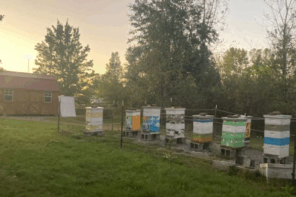Click Here if you listened. We’d love to know what you think. There is even a spot for feedback!
Read along below!
The Flow Suit
By: Stephen Bishop
My wife is a big believer in weather-appropriate clothing. In the morning, she consults a weather app on her phone to inform her wardrobe decisions for the day. Sometimes after I’ve gone outside to feed our menagerie of farm animals, she will verify her electronic intel with my on-the-ground observations. The problem is my observational powers require about three-hundred milligrams of caffeine before they activate.
“Is it cold outside?” she inquires.
“I think so,” I say.
“Will I need a jacket?”
“Maybe.”
Plus, as beekeepers, we don’t have the luxury of making nuanced, weather-appropriate clothing decisions. Our options are “jacket” or “suit.” Last year, I broke down and bought a fancy bee jacket, one of those multilayer mesh types with improved breathability. I am pleased to report that I was only cooked medium-well during our July honey harvest.
Partly, I decided to finally purchase a new bee jacket because my old one was riddled with holes and tears that hindered its usefulness as personal protective equipment. Also, I probably hadn’t washed that jacket twice in ten years. Sadly, there is only so much you can do to mend a jacket before it ceases to be a washable product and instead becomes a 60% cotton, 40% duct tape blend. The problem with duct tape is that after a few years it loses its adhesiveness, and a flapping duct tape patch is more or less the bee equivalent of a flashing neon sign that says, “open.”
Still, that old jacket served me well. That said, during July honey harvests, it felt like the temperature and humidity conditions inside it were best-suited for lifeforms associated with hydrothermal sea vents. In fact, I’m pretty sure there was some form of coral growing on the outside of my old jacket, though it could have just been an advanced form of mold that feeds off of a diet of sugar syrup and honey residue. I have kept that old jacket — I figure if I ever need to emerge from the surf and scare beachgoers, it could be quite useful as a sea monster costume.
Speaking of sea and surf, I have long pondered the concept of the diving bell. Could the idea of piping air down to diving suits be adapted in some form to pipe air conditioning to bee suits? I have even gone so far as to build a simple prototype using a garden hose, small oil funnel, duct tape and XXL bee suit that I had picked up at a yard sale (but never used because it was several sizes too big).
For the prototype, I duct-taped the wide end of the funnel over an air vent in my truck. The small end of the funnel fed into one end of the garden hose, which I wrapped with duct tape to prevent air leaks. The garden hose then delivered cool air into one of the baggy pants legs of my bee suit. For a few minutes, this simple design worked remarkably well, and I thought I had actually invented something beneficial for beekeepers the world over.
However, it wasn’t long before my self-adulation ceased and panic set in, mostly because of two major design flaws: my truck’s unreliable AC and the excessive amount of duct tape I used to seal my ankles and wrists to prevent cool air from escaping. In fact, after about thirty minutes, I had floated upward above all but the tallest trees. Thankfully, the garden hose tethered me to earth and prevented a giant marshmallow from floating further into outer space.
Despite that minor malfunction (and possible violation of airspace regulations), I believe the design could be improved upon and marketed with mass appeal to beekeepers and hot air balloonists alike. If the Flow Hive caught on, why not the Flow Suit?












